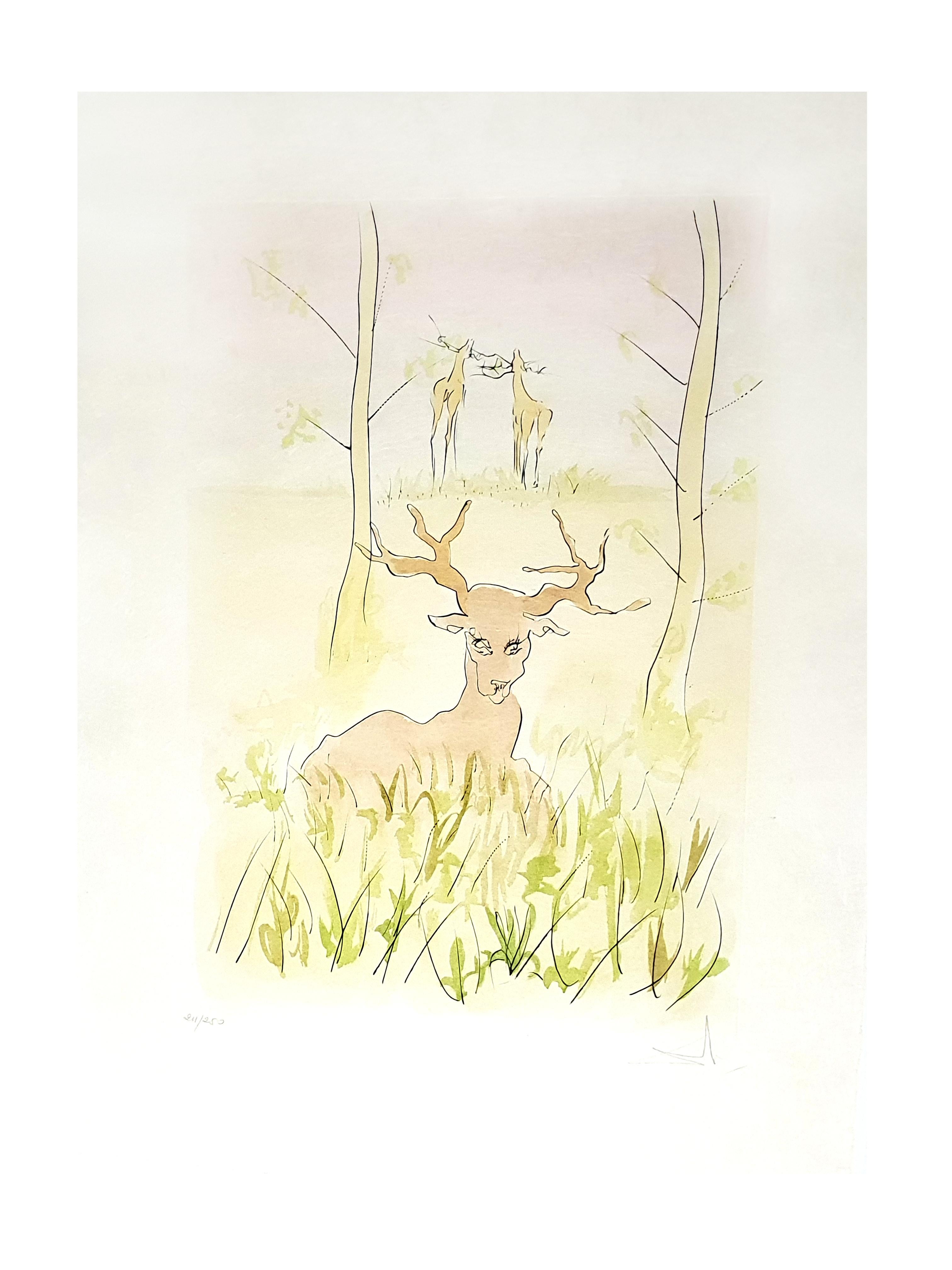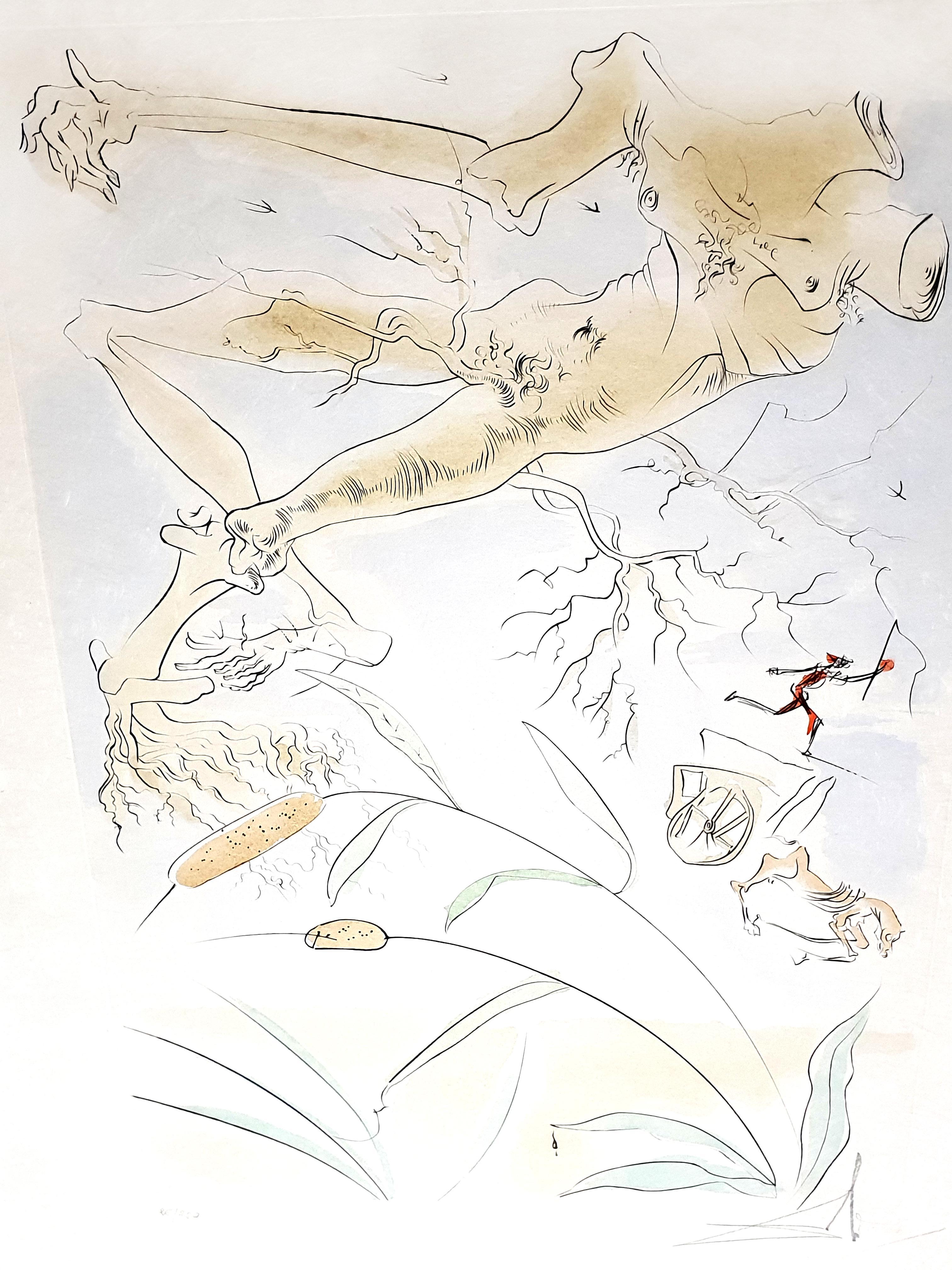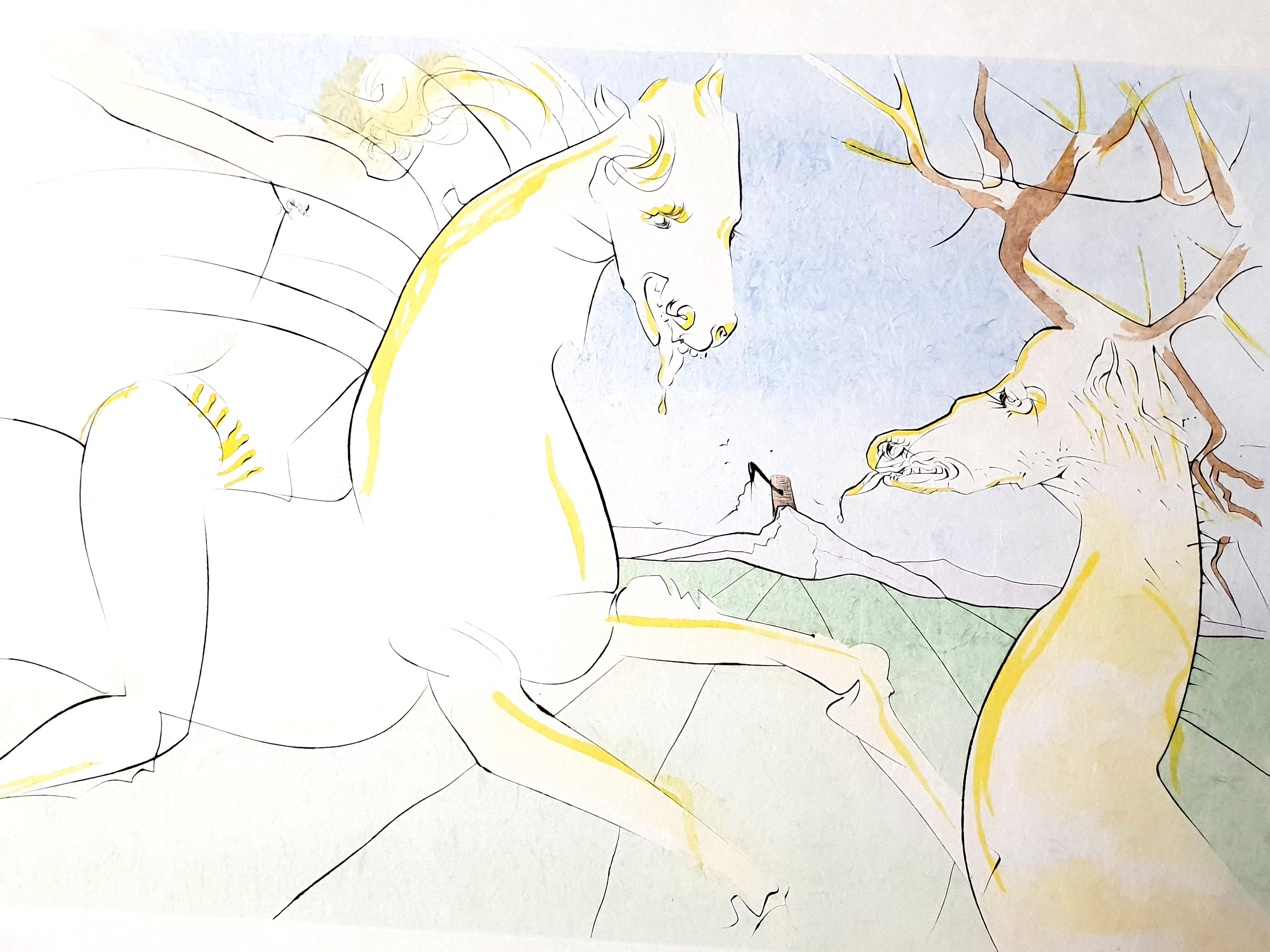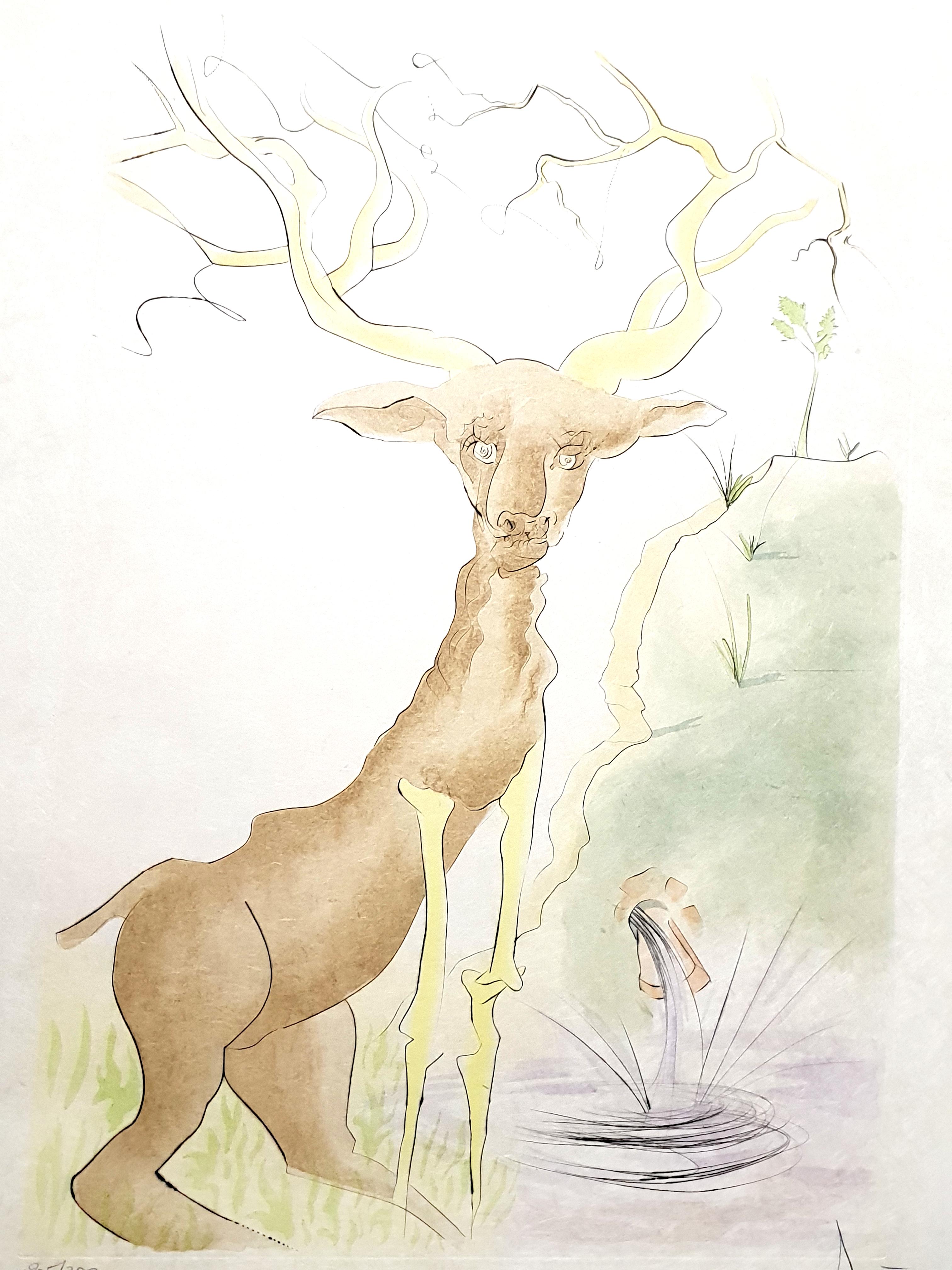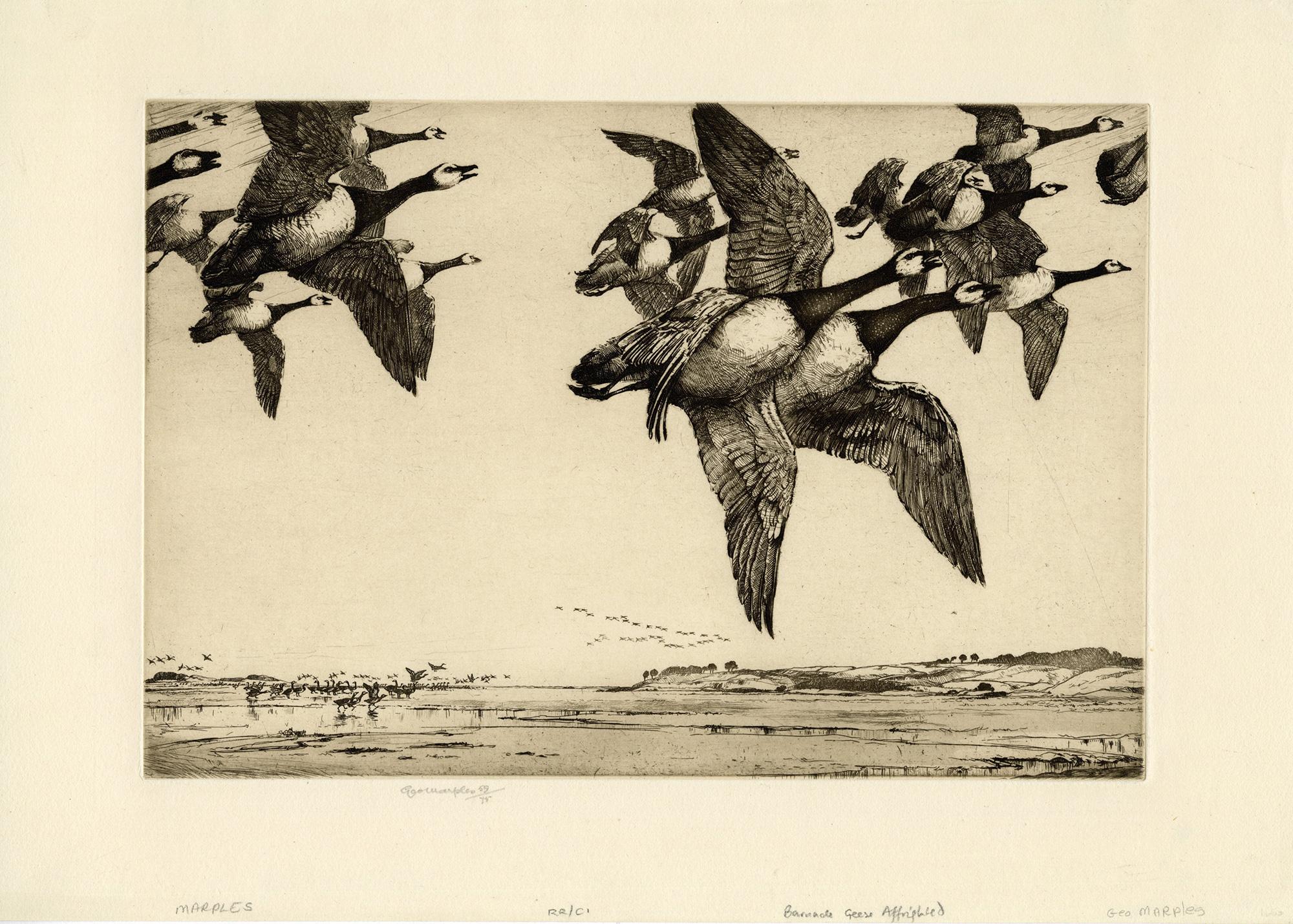Items Similar to Il Barocciaio - Etching and Drypoint by A. Checchi - 1939
Want more images or videos?
Request additional images or videos from the seller
1 of 5
Arturo Checchi Il Barocciaio - Etching and Drypoint by A. Checchi - 19391939
1939
About the Item
Il barrocciaio is a superb etching, drypoint and burin on an ivory-colored laid paper, realized in 1939 by the Italian artist Arturo Checchi (1886-1971)
Signed in pencil on lower right margin, and dated, titled and numbered in Arabic numerals and in pencil on lower left margin.
From a very rare edition of 45 pieces.
Representing a genre scene of ordinary life in Fucecchio, the Tuscan town best-known for the leather processing, this modern artwork has extraordinary beauty in the incisive, rapid line and in his deep blacks. Moreover, the eye falls in the rethinking of the profile of the cat in the lower right corner.
in very good condition, except some minor signs of the time as the usual yellowing of the paper at the edges and some light abrasions of the paper on the margins. . this defect does not affect the image, that has preserved the freshness of the sign, and the lifetime impressions in addition to a superb inking.
Exhibited at the Second Biennale Internazionale of Graphic Works at Palazzo Strozzi, Firenze, in 1970, n. 5 p. 114.
Arturo Checchi (Fucecchio, 1886 - Perugia, 1971)
The Italian painter started drawing with a private teacher when he was 12 and in 1902 he attended the Academy of Fine Arts in Florence for three years under the guidance of Alfonso De Carolis. Once the Academy was finished, he began his activity as a decorator and continued his studies in drawing until the outbreak of the First World War, which forced him to return to Fucecchio.
After his first artistic training, he traveled to Germany, where he met the Jugend painters and the expressionists.
He taught at the Academies of Perugia (from 1925, and where he married one of his students, Zena Fettucciari), of Brera (from 1939) and Florence (from 1942 to 1961)
Adhering to the Tuscan pictorial taste of the time, Checchi was among the first painters to orient himself to the style of Cézanne, which Vittorio Pica introduced in Italy in 1908 with the publication The French Impressionists, "influenced by the admirable capacity for synthesis and the will of the French to create abstract harmonies of masses and tones ». His palette was also enriched by a coloristic incisiveness drawn from Van Gogh and Gauguin.
Since 1975 two sculptures have been exhibited in Vallombrosa: La sirena (1932) and Bimba al sole (1935). In Perugia are exhibited Il violino (gardens of piazza Italia) and La chitarra (foyer of the Teatro Morlacchi).
He held several personal exhibitions in Florence; he participated in the Venice Biennale (in 1926, 1928, 1932, 1934, 1936 and 1940), in the first eight editions of the Rome Quadrennial and in graphic collective exhibitions in Florence, New York, Paris, Warsaw, Riga.It was also present at the Exhibition International art fair in Barcelona, launched in 1931 by the National Fascist Union. Also known as etcher and draftsman, he took part in the International Exhibition of Graphics at Palazzo Strozzi in 1968-69 and published Images, 33 original lithographs, Fucecchio of that time, 44 etchings and juvenile woodcuts, as well as other engravings.
This artwork is shipped from Italy. Under existing legislation, any artwork in Italy created over 70 years ago by an artist who has died requires a licence for export regardless of the work’s market price. The shipping may require additional handling days to require the licence according to the final destination of the artwork.
- Creator:Arturo Checchi (1886 - 1971)
- Creation Year:1939
- Dimensions:Height: 14.06 in (35.7 cm)Width: 19.97 in (50.7 cm)Depth: 0.08 in (2 mm)
- Medium:
- Period:
- Condition:Insurance may be requested by customers as additional service, contact us for more information.
- Gallery Location:Roma, IT
- Reference Number:
About the Seller
4.9
Platinum Seller
These expertly vetted sellers are 1stDibs' most experienced sellers and are rated highest by our customers.
1stDibs seller since 2017
6,749 sales on 1stDibs
Typical response time: 2 hours
- ShippingRetrieving quote...Ships From: Rome, Italy
- Return PolicyA return for this item may be initiated within 14 days of delivery.
More From This SellerView All
- The Cat - Etching and Drypoint by Giselle Halff- 1950sBy Giselle HalffLocated in Roma, ITThe Cat is an Original etching and drypoint print on paper realized by an Anonymous artist in 1950 ca. Good conditions with some foxing.Category
1950s Modern Figurative Prints
MaterialsEtching, Drypoint
- Study of Five Heads - Original Etching by J.-J. BoissieuBy Jean-Jacques de BoissieuLocated in Roma, ITStudy of Five Heads is a beautiful black and white etching with drypoint interventions on paper, realized at the end of XVIII century by the French artist Jean-Jacques de Boissieu (Lyon, 1736- 1810). Five study of heads of which two profiles (a female and a male) are lightly sketched with the drypoint technique, and we could appreciate the incredible draftsmanship. Instead, the bigger three portraits are very detailed and etched with a superb technique. Although the subjects are drawn in different scales and with different degrees of finish, each portrait has the dignity of a unique piece and the composition is very balanced. In particular on the lower margin at the center there is the portrait of "Le Père Cotrot, Garçon Teinturier à Lyon'", an elderly man, toothless and with a large-nosed, slightly turned to left, with a hat and unbuttoned jacket over waistcoat, shows all his wrinkles in a very realistic way. Signed on plate on lower right margin “De Boissieu”. This old master’s original print with fresh impressions, is in very good conditions, except for a usual yellowing of the paper above all on the edges and some signs of the time and light foxing along the margins, do not affect the image. Jean-Jacques de Boissieu (Lyon,1736 –1810) Jean-Jacques de Boissieu was a French artist studied at the École de Dessin in Lyon, but he was mostly self-taught. His first prints were realized between 1758–64. When he went to Italy in the retinue of the ambassador and Duc de la Rochefoucauld d’Enville, he had the lifechanging encounter: he met Voltaire and he entered in the world of luminaries, he had the opportunity of realizing some plates for the Diderot-d’Alembert’s Encyclopèdie. Then he continued to produce prints in Lyon, Boissieu made many etchings of the Roman and Dutch countryside, as well as the French countryside around Lyon, which earned him a reputation as the last representative of the older etching...Category
Late 18th Century Old Masters Animal Prints
MaterialsEtching, Drypoint
- Study of Six Heads - Etching by J.-J. BoissieuBy Jean-Jacques de BoissieuLocated in Roma, ITStudy of Six Heads is a beautiful black and white etching with drypoint interventions on paper, realized at the end of XVIII century by the French artist Jean-Jacques de Boissieu (Lyon, 1736- 1810). Six study od heads ( four elder men, a middle-aged man at the center, and a woman with turbant) etched with a superb technique and an incredible draftsmanship are drawn to different scales and with different degrees of finish, have the dignity of six different portraits with the same passion and effort. Signed on plate on lower right margin “De Boissieu”. Inscription ( number plate) on higher-right corner "10". This old master’s original print with lifetime impressions, is in very good conditions, except for a usual yellowing of the paper above all on the edges and some signs of the time,do not affect the image. Jean-Jacques de Boissieu (Lyon,1736 –1810) Jean-Jacques de Boissieu was a French artist studied at the École de Dessin in Lyon, but he was mostly self-taught. His first prints were realized between 1758–64. When he went to Italy in the retinue of the ambassador and Duc de la Rochefoucauld d’Enville, he had the lifechanging encounter: he met Voltaire and he entered in the world of luminaries, he had the opportunity of realizing some plates for the Diderot-d’Alembert’s Encyclopèdie. Then he continued to produce prints in Lyon, Boissieu made many etchings of the Roman and Dutch countryside, as well as the French countryside around Lyon, which earned him a reputation as the last representative of the older etching...Category
Late 18th Century Old Masters Animal Prints
MaterialsEtching, Drypoint
- Horse - Original Drypoint by Helen Norton - 1930By Helen NortonLocated in Roma, ITHorse is an original artwork realized by the American artist Helen Norton in 1930. Original drypoint on paper. Hand-signed and dated in pencil by the artist on the lower right corne...Category
1930s Modern Animal Prints
MaterialsDrypoint
- Owl - Etching on Paper by Mario Avati - 1960sBy Mario AvatiLocated in Roma, ITOwl is an etching on paper, realized by the French artist and print-maker master Mario Avati (1921-2009). Hand-signed on the lower right and numbered on the lower left in pencil. Ed...Category
1960s Figurative Prints
MaterialsMezzotint, Etching
- Animal Figures of Ancient Rome - Etching - 18th CenturyBy Vincenzo AlojaLocated in Roma, ITAnimal Figures of Ancient Rome from the Antiquities of Herculaneum Exposed, original etching from the end of the 18th century realized by Vincenzo Aloja. In very good condition, exc...Category
18th Century Modern Animal Prints
MaterialsEtching
You May Also Like
- Salvador Dali - Le Cerf from Le Bestiaire de la Fontaine - Signed EngravingBy Salvador DalíLocated in Collonge Bellerive, Geneve, CHSALVADOR DALI Le Cerf Malade from Le Bestiaire de la Fontaine 1974 Hand signed by Dali Edition: /250 The dimensions of the image are 22.8 x 15.7 inches on 31 x 23.2 inch paper Refer...Category
1970s Surrealist Figurative Prints
MaterialsDrypoint, Aquatint
- Salvador Dali - The Oak and the Reed - Signed EngravingBy Salvador DalíLocated in Collonge Bellerive, Geneve, CHSALVADOR DALI The Oak and the Reed (La chêne et le roseau) from Le Bestiaire de la Fontaine 1974 Hand signed by Dali Edition: /250 Conditions: A small tear defect has been restaured...Category
1970s Surrealist Figurative Prints
MaterialsDrypoint, Aquatint
- Salvador Dali - The Rider and the Deer - Handsigned EngravingBy Salvador DalíLocated in Collonge Bellerive, Geneve, CHSalvador Dali - The Rider and the Deer - Handsigned Engraving 1974 Hand signed by Dali Edition: /250 The dimensions of the image are 22.8 x 15.7 inches on 3...Category
1970s Surrealist Figurative Prints
MaterialsDrypoint, Aquatint
- Salvador Dali - Le Cerf from Le Bestiaire de la Fontaine - Signed EngravingBy Salvador DalíLocated in Collonge Bellerive, Geneve, CHSALVADOR DALI Le Cerf se voyant dans l'eau from Le Bestiaire de la Fontaine 1974 Hand signed by Dali Edition: /250 The dimensions of the image are 22.8 x 15.7 inches on 31 x 23.2 in...Category
1970s Surrealist Figurative Prints
MaterialsDrypoint, Aquatint
- Barnacle Geese AffrightedLocated in Middletown, NYEtching and drypoint on cream wove paper, full margins. Signed and numbered 59/75 in pencil, lower margin. Notations in pencil along the lower sheet edge, recto, well outside of ima...Category
Mid-20th Century Modern Animal Prints
MaterialsHandmade Paper, Drypoint, Etching
- Night Time, Dieppe.By Edmund BlampiedLocated in Storrs, CTNight Time, Dieppe. 1926-27. Drypoint. Appleby 123. 7 7/8 x 11/ Edition 100. A fine impression printed on cream laid paper with full margins. Signed in penc...Category
1920s Modern Figurative Prints
MaterialsDrypoint, Etching
Recently Viewed
View AllMore Ways To Browse
1939 Fair
1939 World Fair
1939 Worlds Fair
New York Worlds Fair 1939
Vintage 1939 New York Worlds Fair
Cat 1930
Vintage Black Cat Drawing
Yellow Cat Sculpture
Arabic Market
Cat Woodcut
Woodcut Prints Cat
Tuscan Sculpture
Tuscan Garden
Etched Ivory
Van Gogh Ink Drawing
Van Gogh Etching
Il Teatro
Van Gogh Etching Original
